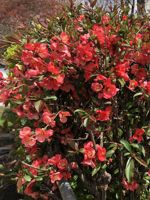Mon-Fri 9am - 5pm Mountain time
Japanese Quince vs Yellow Hedysarum
Chaenomeles japonica
Hedysarum sulphurescens
NOT AVAILABLE THIS SEASON - MIGHT RETURN
CUSTOM GROW
Japanese Quince has bright, orange to red showy flowers that bloom in early spring. The flowers appear before the leaves and may continue to bloom after leaves emerge. Flowers grow on old wood, so pruning after flowering will help to promote new growth next spring. They produce yellow-green fruit that taste bitter when eaten raw, typically they are better suited for making preserves.
It can be used as a stand alone ornamental shrub, as a low hedge, or can be trained to grow against a wall. In late winter, branches of Japanese Quince can be cut and brought indoors where they will bloom on their own. They are deer and rabbit tolerant. The branches are spiny making them well suited for keeping unwanted wildlife away.
Yellow Hedysarum is a native perennial wildflower recognized for its clusters of pale yellow to creamy-white, pea-like blooms. Flowering from late spring into summer, it adds subtle colour to grasslands, roadsides, and open woods while attracting a variety of pollinators, especially bumblebees.
As a nitrogen-fixing plant, Yellow Hedysarum enriches soils and supports the growth of surrounding vegetation. Its deep taproot and extensive root system make it drought-tolerant and effective at stabilizing soil. Grizzly bears are known to dig up and eat the nutritious taproot. Its resilience and ecological value make it well-suited for restoration, naturalization, pollinator gardens, and erosion control projects.

